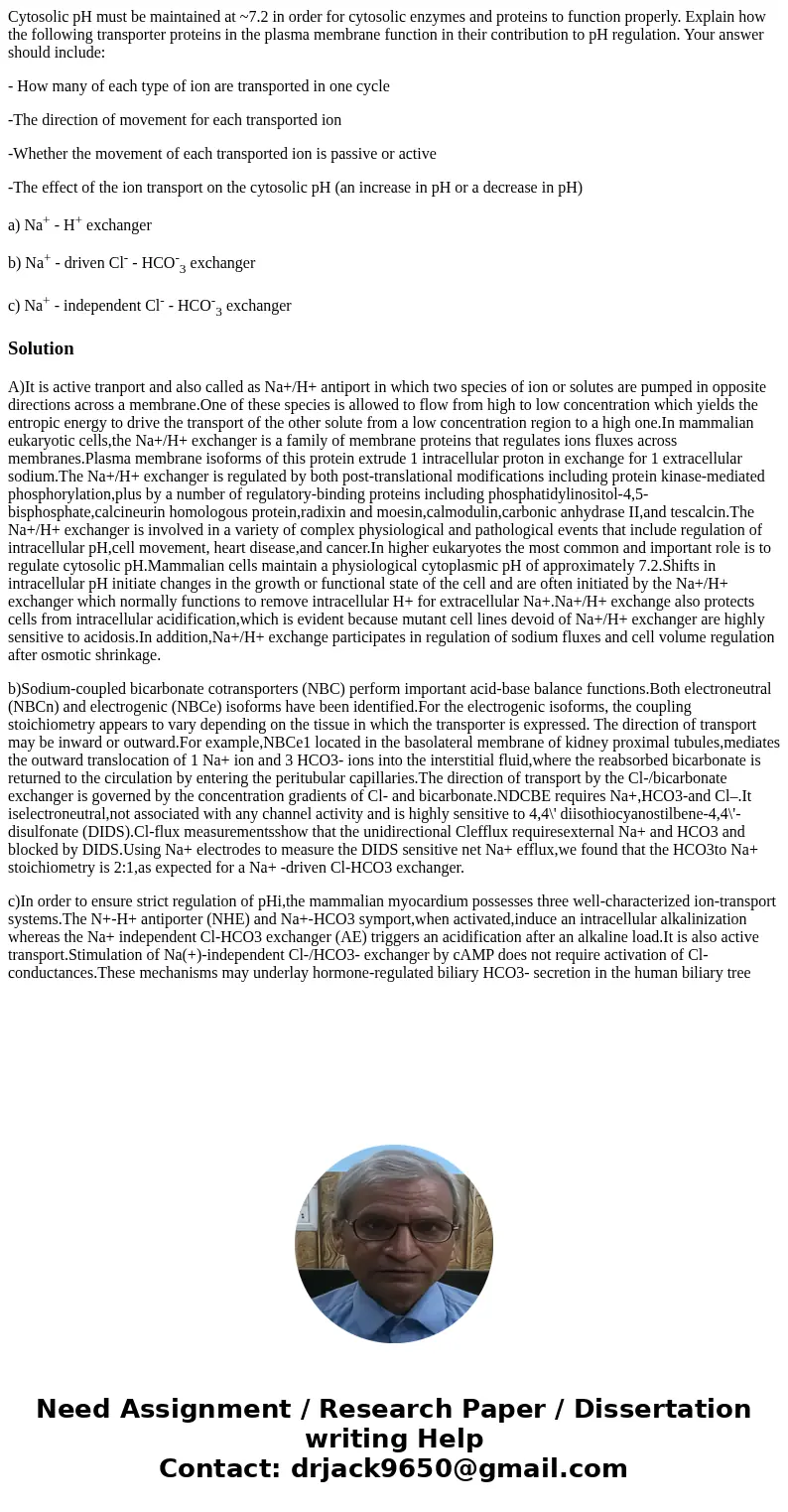Cytosolic pH must be maintained at 72 in order for cytosolic
Cytosolic pH must be maintained at ~7.2 in order for cytosolic enzymes and proteins to function properly. Explain how the following transporter proteins in the plasma membrane function in their contribution to pH regulation. Your answer should include:
- How many of each type of ion are transported in one cycle
-The direction of movement for each transported ion
-Whether the movement of each transported ion is passive or active
-The effect of the ion transport on the cytosolic pH (an increase in pH or a decrease in pH)
a) Na+ - H+ exchanger
b) Na+ - driven Cl- - HCO-3 exchanger
c) Na+ - independent Cl- - HCO-3 exchanger
Solution
A)It is active tranport and also called as Na+/H+ antiport in which two species of ion or solutes are pumped in opposite directions across a membrane.One of these species is allowed to flow from high to low concentration which yields the entropic energy to drive the transport of the other solute from a low concentration region to a high one.In mammalian eukaryotic cells,the Na+/H+ exchanger is a family of membrane proteins that regulates ions fluxes across membranes.Plasma membrane isoforms of this protein extrude 1 intracellular proton in exchange for 1 extracellular sodium.The Na+/H+ exchanger is regulated by both post-translational modifications including protein kinase-mediated phosphorylation,plus by a number of regulatory-binding proteins including phosphatidylinositol-4,5-bisphosphate,calcineurin homologous protein,radixin and moesin,calmodulin,carbonic anhydrase II,and tescalcin.The Na+/H+ exchanger is involved in a variety of complex physiological and pathological events that include regulation of intracellular pH,cell movement, heart disease,and cancer.In higher eukaryotes the most common and important role is to regulate cytosolic pH.Mammalian cells maintain a physiological cytoplasmic pH of approximately 7.2.Shifts in intracellular pH initiate changes in the growth or functional state of the cell and are often initiated by the Na+/H+ exchanger which normally functions to remove intracellular H+ for extracellular Na+.Na+/H+ exchange also protects cells from intracellular acidification,which is evident because mutant cell lines devoid of Na+/H+ exchanger are highly sensitive to acidosis.In addition,Na+/H+ exchange participates in regulation of sodium fluxes and cell volume regulation after osmotic shrinkage.
b)Sodium-coupled bicarbonate cotransporters (NBC) perform important acid-base balance functions.Both electroneutral (NBCn) and electrogenic (NBCe) isoforms have been identified.For the electrogenic isoforms, the coupling stoichiometry appears to vary depending on the tissue in which the transporter is expressed. The direction of transport may be inward or outward.For example,NBCe1 located in the basolateral membrane of kidney proximal tubules,mediates the outward translocation of 1 Na+ ion and 3 HCO3- ions into the interstitial fluid,where the reabsorbed bicarbonate is returned to the circulation by entering the peritubular capillaries.The direction of transport by the Cl-/bicarbonate exchanger is governed by the concentration gradients of Cl- and bicarbonate.NDCBE requires Na+,HCO3-and Cl–.It iselectroneutral,not associated with any channel activity and is highly sensitive to 4,4\' diisothiocyanostilbene-4,4\'-disulfonate (DIDS).Cl-flux measurementsshow that the unidirectional Clefflux requiresexternal Na+ and HCO3 and blocked by DIDS.Using Na+ electrodes to measure the DIDS sensitive net Na+ efflux,we found that the HCO3to Na+ stoichiometry is 2:1,as expected for a Na+ -driven Cl-HCO3 exchanger.
c)In order to ensure strict regulation of pHi,the mammalian myocardium possesses three well-characterized ion-transport systems.The N+-H+ antiporter (NHE) and Na+-HCO3 symport,when activated,induce an intracellular alkalinization whereas the Na+ independent Cl-HCO3 exchanger (AE) triggers an acidification after an alkaline load.It is also active transport.Stimulation of Na(+)-independent Cl-/HCO3- exchanger by cAMP does not require activation of Cl- conductances.These mechanisms may underlay hormone-regulated biliary HCO3- secretion in the human biliary tree

 Homework Sourse
Homework Sourse